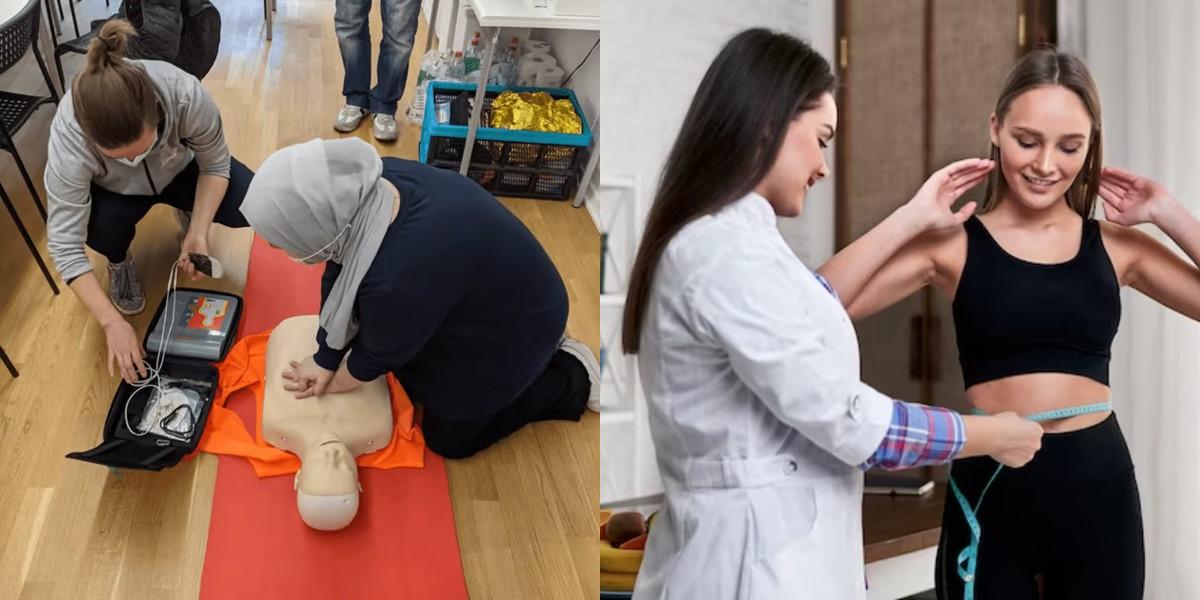CPR-BLS vs Personal Trainer and Nutrition Coach
SearchPersonal Trainer
classes near 43215

Key Points:
- CPR-BLS providers focus on emergency first aid, while Personal Trainers and Nutrition Coaches work on fitness and dietary guidance.
- CPR-BLS pay can vary, while Personal Trainers and Nutrition Coaches often earn higher salaries based on their specialized skills.
- CPR-BLS roles are widely available, while Personal Trainer and Nutrition Coach jobs may depend on the local fitness market.
- CPR-BLS training is often online or in-person, while Personal Trainers and Nutrition Coaches typically require in-person certification programs.
- CPR-BLS training is generally more affordable and shorter than the extensive programs for Personal Trainers and Nutrition Coaches.
Before we delve into the differences between CPR-BLS providers and personal trainers and nutrition coaches, let's first define what each role entails.
What is a CPR-BLS and Personal Trainer and Nutrition Coach?
CPR-BLS: CPR-BLS stands for Cardio-Pulmonary Resuscitation-Basic Life Support. CPR-BLS providers are trained in life-saving techniques, such as performing CPR, using an automated external defibrillator (AED), and providing basic first aid. They are often the first responders in emergency situations, providing immediate care until medical professionals arrive. CPR-BLS providers can work in a variety of settings, including hospitals, clinics, schools, and community organizations.
Personal Trainer and Nutrition Coach: Personal trainers and nutrition coaches focus on helping individuals improve their physical fitness and overall health through exercise and proper nutrition. They create customized workout plans, provide guidance on nutrition and diet, and offer support and motivation to help their clients achieve their fitness goals. Personal trainers and nutrition coaches can work in fitness centers, gyms, wellness clinics, or as independent contractors.
Difference between a CPR-BLS and Personal Trainer and Nutrition Coach
While both CPR-BLS providers and personal trainers and nutrition coaches work in the healthcare and fitness industry, there are several key differences between the two roles:
-
Scope of Practice: CPR-BLS providers are focused on emergency care and are trained to respond quickly and effectively in life-threatening situations. Their primary goal is to stabilize patients and provide immediate care until medical professionals take over. On the other hand, personal trainers and nutrition coaches focus on long-term health and wellness goals, helping clients improve their overall fitness and maintain a healthy lifestyle.
-
Training and Certification: To become a CPR-BLS provider, individuals must complete a certification program that includes training in CPR techniques, AED usage, and basic first aid. These programs are typically short in duration, ranging from a few hours to a few days. Personal trainers and nutrition coaches, on the other hand, often pursue more extensive training and certification programs. They may complete courses in exercise science, nutrition, anatomy, and physiology, and obtain certifications from organizations such as the National Academy of Sports Medicine (NASM) or the American Council on Exercise (ACE).
-
Clientele: CPR-BLS providers work with a wide range of individuals, including patients in hospitals or clinics, students in schools, and members of the community. Their clients are often in need of immediate medical attention and may be experiencing life-threatening situations. Personal trainers and nutrition coaches, on the other hand, typically work with individuals who are looking to improve their fitness, lose weight, or maintain a healthy lifestyle. Their clients may include athletes, individuals recovering from injuries, or those who simply want to improve their overall well-being.
-
Work Environment: CPR-BLS providers can work in a variety of settings, including hospitals, clinics, schools, and community organizations. They are often on-call and may need to respond to emergencies at any time. Personal trainers and nutrition coaches, on the other hand, typically work in fitness centers, gyms, or wellness clinics. They may also offer their services as independent contractors and work with clients in their homes or other locations.
CPR-BLS vs Personal Trainer and Nutrition Coach: Job Description
Now that we have discussed the differences between CPR-BLS providers and personal trainers and nutrition coaches, let's take a closer look at the job descriptions for each role:
CPR-BLS Provider Job Description:
- Respond to emergency situations and provide immediate care to stabilize patients
- Perform CPR and use an AED as needed
- Administer basic first aid and assist with wound care
- Communicate with medical professionals and provide them with relevant information
- Stay current on the latest CPR and first aid techniques through ongoing training and certification
Personal Trainer and Nutrition Coach Job Description:
- Assess clients' fitness levels and create customized workout plans
- Provide guidance on nutrition and diet to help clients achieve their health and fitness goals
- Teach proper exercise techniques and ensure clients are performing exercises safely and effectively
- Motivate and support clients to help them stay on track with their fitness goals
- Stay current on the latest research and trends in fitness and nutrition
CPR-BLS vs Personal Trainer and Nutrition Coach: Education and Training
The education and training requirements for CPR-BLS providers and personal trainers and nutrition coaches differ significantly:
CPR-BLS Provider Education and Training:
- Completion of a CPR-BLS certification program
- Training in CPR techniques, AED usage, and basic first aid
- Continuing education to stay current on the latest CPR and first aid techniques
Personal Trainer and Nutrition Coach Education and Training:
- Completion of a personal training certification program
- Courses in exercise science, nutrition, anatomy, and physiology
- Certification from a recognized organization such as NASM or ACE
- Continuing education to stay current on the latest research and trends in fitness and nutrition
Get courses selected just for you
Try our powerful search engine
CPR-BLS vs Personal Trainer and Nutrition Coach: Career Outlook and Salary
When it comes to career outlook and salary, both CPR-BLS providers and personal trainers and nutrition coaches have promising opportunities:
CPR-BLS Provider Career Outlook and Salary:
- According to the Bureau of Labor Statistics (BLS), employment of emergency medical technicians (EMTs) and paramedics, which includes CPR-BLS providers, is projected to grow 7 percent from 2018 to 2028, faster than the average for all occupations.
- The median annual wage for EMTs and paramedics was $35,400 in May 2018, according to the BLS.
Personal Trainer and Nutrition Coach Career Outlook and Salary:
- The BLS projects that employment of fitness trainers and instructors, which includes personal trainers, will grow 13 percent from 2018 to 2028, much faster than the average for all occupations.
- The median annual wage for fitness trainers and instructors was $39,820 in May 2018, according to the BLS.
Final Thoughts
Both CPR-BLS providers and personal trainers and nutrition coaches play important roles in helping individuals improve their health and well-being. While CPR-BLS providers focus on emergency care and immediate life-saving techniques, personal trainers and nutrition coaches take a long-term approach to fitness and wellness. Ultimately, the choice between these two career paths depends on your interests, skills, and goals. If you enjoy the fast-paced nature of emergency care and want to make a difference in life-threatening situations, becoming a CPR-BLS provider may be the right choice for you. If you are passionate about fitness, nutrition, and helping others achieve their fitness goals, a career as a personal trainer and nutrition coach may be the perfect fit.
Explore Dreambound's programs, conveniently offered in multiple locations. Learn more about these two vocations by visiting:

Winlynd Caballero is a member of Dreambound's Sales team. She helps in handling the company's finullcial transactions, generating reports, and school sales. Beyond her responsibilities in the realm of numbers and business, Winlynd finds herself deeply immersed in a world of art and music.
